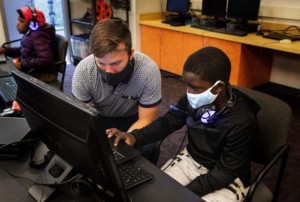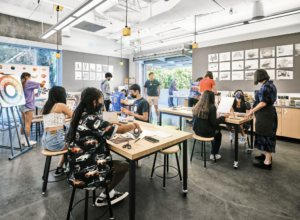Q&A: Internet Is a Community Connection With WeCan

Ulik Broida, Vice President of Products at Alvarion, and Nicole Robinson, Digital Inclusion Director at the Houston Public Library WeCan, join us today to share the impact of the Internet on communities to bring new knowledge, learning, and careers.
SC: What impact has Internet access had on education and learning?
Ulik Broida: The Internet has been transformative for education by delivering information to anyone with access to a computer, or nowadays, a web-enabled device. Wireless broadband access in particular has made it possible to connect not just the classroom, but also an entire campus community (physical or virtual) including administration, security personnel and others involved in day-to-day operations. In fact, I believe mobility is a major trend that will continue to change the face of education and drive major technology purchasing decisions over the next five to ten years.
By decentralizing resources and opening it up to the masses, the Internet has helped break down the knowledge barriers at all levels. The Internet is providing the valuable teaching and collaboration tools necessary for educators to better reach students and improve learning outcomes, wherever they may be located around the globe. For example, a rising number of prestigious universities, like Stanford, are now offering free online courses with multimedia and interactive experiences with faculty. Just think too, without the Internet, organizations like the The Khan Academy could not deliver on its mission of “providing a high quality education to anyone, anywhere” via the web.
SC: How does the Internet bridge the digital divide for students of all backgrounds?
Nicole Robinson: The knowledge and skills necessary to work, prosper and participate in current society are tied to educational attainment and the ability to access and use information and communication technology tools. Reports have confirmed that young people with Internet access and a computer do better in school and are more likely to stay in school as a result. This is critically-important given that in 2009, 53.9% of students in Harris County public schools were considered at risk of dropping out. This lost potential in learning has consequences far beyond the classroom: 191,000 unfilled jobs and over 2 million high school graduates unable to seize this opportunity because they have been poorly prepared. Additionally, every student who doesn’t complete high school costs our society $260,000 in lost earnings, taxes, productivity (Annie E. Casey Foundation, Kids Count 2010). Coincidently, Texas ranks last in the nation in the percentage of adults with high school diplomas; with only 70% of Houstonians having a high school diploma.
By 2014, more than 77% of all jobs in the US will require some level of computer literacy. However, only 13% of American adults are proficient in the knowledge and skills needed to identify and perform computational tasks and 1/3 of American adults will remain without access to that training. As a result of this nationwide skills gap, 52% of American employers are experiencing difficulty filling mission-critical positions. The shortage of skilled workers high-tech workers is an indication of just how ill-prepared America is to meeting today’s changing labor market needs. At stake as a result of this digital exclusion, is not only the ability to participate effectively in the global information society, but our future economic sustainability and personal quality of life. According to the Department of Labor’s report “Tomorrow’s Jobs,” professional and related occupations will grow the fastest and add more new jobs than any other major occupational group. About three quarters of the job growth will come from three groups of professional occupations – computer and mathematical occupations, technical occupations and health care practitioners. For 49 out of the 50 highest paying occupations, a college degree or higher is the most significant source of education or training. These numbers further confirm that youth and adults without these core skills may find themselves on the periphery of 21st century society.
SC: The Internet is at the forefront of the informal learning boom. How can classrooms leverage informal learning to boost student engagement, achievement, etc.?
Ulik Broida: The digital divide is narrowing as broadband access to rural and underserved areas increases. As a result, more and more children today are gaining access to the Internet in their daily lives – in and outside the classroom. In the home, video games, text and tablets are wiring students’ minds for the 21st century digital world. When those children go to school, it comes to reason that the best way to reach them is through similar means. This trend can also be seen in developments such as the gamification of education, where teachers are using games, apps and more to deliver impactful and meaningful instruction. Aside from instructor-led curriculum, students are constantly absorbing information via parents, peers, and other influencers. The Internet provides tools to bring, share, and build upon this knowledge in a constructive way.
SC: We talk a lot about the flipped classroom and bring your own device (BYOD). What role does community- or school-wide Internet access play in the success of those new learning models?
Ulik Broida: Whether purchased by the school, teacher and the student, it’s undeniable that BYOD will continue to bring more devices like smartphones, laptops and tablets into the classroom than ever before. They are a key to unlocking the potential of these devices is the ability to connect them through the Internet. Now more than ever, classrooms have the tools to bring learning online and enhance lesson plans through collaboration software, multimedia resources, social media, and more – but you need an intelligent underlying network infrastructure, including wireless broadband, to connect the dots seamlessly.
Teachers and administrators are under constant pressure nowadays in terms of tightening budgets and emerging standards, such as Common Core. In the end, it’s all about being able to offer the teaching model that best fit the needs of the individual student. Internet access provides the flexibility needed to reach students in the way they learn best – regardless of traditional or flipped – so that students and faculty have access to all of the best resources, course material, and each other.
SC: WeCAN is working to close the digital divide with increased knowledge and access to tech and online resources. How many neighborhoods or organizations has WeCAN impacted?
Nicole Robinson: For those without any broadband Internet access at home, libraries rank among the top places where the Internet is accessed. As meaningful connections are increasingly available primarily online, these groups will be further disconnected from economic opportunity, social services and organizations established to assist them. If we take full advantage of the social and economic opportunities presented through this initiative, we have the potential to positively impact over a half a million people across the city by making digital literacy and access to technology a means to acquire the skills, education and certifications needed to achieve real quality of life change and create economic opportunity for themselves and generations to come.
Through the award winning Digital Inclusion Initiative, Houstonians are able to take advantage of WeCAN via qualified Community Access Locations (CALs) such as city multi-service centers and community centers, as well as schools and community-based organizations, located in targeted underserved super neighborhoods across the city. The WeCAN CALs are staffed by people who provide computer training and who help residents access the online resources they need. Additionally, strategic placement of Wi-Fi zones in these high need super neighborhoods, are deployed to complement the access to education and skills training at the neighborhood WeCAN CALs as well as to help facilitate the goal of increased access, promotion and development of wireless technology in support of broadband adoption. The target goal is to establish a minimum of 3 community access locations per neighborhood and 5 Wi-Fi zones across 10 designated super neighborhoods. The current WeCAN network consists of 16 community access locations and 65 Wi-Fi Zones within these neighborhoods and expansion plans to be completed by June 2012, impacting over 300,000 residents across these neighborhoods.
Houston Public Library, in partnership with the Texas State Library and Archives Commission, received a Broadband Technology Opportunities Program (BTOP) grant as part of the federal government’s American Recovery and Reinvestment Act. The Houston Public Library received an allocation of $3.7 million out of an $8 million total state award for the BTOP Technology Expertise, Access and Learning for ALL Texans (TEAL) to provide Houstonians with greater broadband internet access and much-needed educational and training opportunities, and significantly expand the reach and impact of WeCAN. The grant will help to expand WeCAN programs and services beyond the ten targeted high-need neighborhoods, to an additional 42 neighborhoods, and will place more than 2,000 laptops, netbooks and desktops in 83 community-based library, community center and multi-service public computer centers. Beyond providing access and training that will help Houstonians better their skills and find jobs, this grant gives WeCAN the opportunity to create much needed jobs in our area. In fact, it will create more than 60 full and part time technical and program support jobs.
SC: Can you tell me a story about a particular neighborhood that saw a huge turnaround in access to knowledge, learning and more through the WeCAN effort?
Nicole Robinson: Research on the digital divide reports that factors such as income, education, age, and ethnicity play an important role in determining those populations that are least connected to technology and therefore most disconnected from opportunity. Thus, the targeted super neighborhoods were identified through an extensive and meticulous process involving key stakeholders and based on three major areas of consideration: 1) neighborhood socio-economic condition (need), 2) neighborhood assets (i.e. schools, city facilities, community based organizations, etc.); and, 3) neighborhood initiatives (i.e. Houston Hope, etc.). Thus, all neighborhoods targeted benefit from the following available to residents:
- Increased number of community based computer and broadband Internet centers
- Increased number of computer hardware available in the community
- Free community broadband Internet access, including high-capacity wireless broadband connection equipment
- Increased workforce and digital literacy skills training programs and services
- Increased access to and awareness of government and library programs and services
- Improved awareness of neighborhood resources, programs and services
SC: Why is WeCAN important to the Houston community?
Nicole Robinson: While the City of Houston has a reputation for its technological innovation, many Houstonians have yet to experience the significant civic, educational and economic benefits of the information age. As a result of the recession, Houston has experienced record unemployment with over 240,000 unemployed Houstonians seeking jobs and career changes.This is compounded by the fact Texas ranks last in the nation in the percentage of adults with high school diplomas; with only 70% of Houstonians having a high school diploma (Annie E. Casey Foundation, Kids Count 2010).
By 2014, more than 77% of all jobs in the US will require some level of computer literacy. Consider that today most companies are requiring that job applications be completed online, even for basic entry-level jobs. Individuals without Internet access or the knowledge to use computers and the Internet are further disadvantaged. However, only 13% of American adults are proficient in the knowledge and skills needed to identify and perform computational tasks and 1/3 of American adults will remain without access to that training. As a result of this nationwide skills gap, 52% of American employers are experiencing difficulty filling mission-critical positions. The shortage of skilled workers high-tech workers is an indication of just how ill-prepared America is to meeting today’s changing labor market needs. At stake as a result of this digital exclusion, is not only the ability to participate effectively in the global information society, but our future economic sustainability.
As the fastest growing US city, Houstonians are served well with an initiative that is designed to improve the employability and economic opportunity of Houston’s underserved, unskilled, and unemployed through access to broadband Internet and skills training and certifications necessary to earn higher levels of earnings and create economic opportunity for themselves. Digital inclusion is a critical component to the growth of our city – our community vibrancy, personal quality of life, economic viability, and business competitiveness depend on it.
It is also important to note that while the primary focus for WeCAN will center on Houston’s neediest neighborhoods where the opportunities for impact are most significant, the city of Houston as a whole as the opportunity to benefit from this Initiative through:
- The addition of new resources to the local economy and society,
- Improved relationships between government and citizens,
- Stronger and safer communities, and
- An increased population of self-sufficient, contributing members of society.
SC: What role do public-private partnerships play in WeCAN?
Nicole Robinson: An effort of this significance and magnitude calls for a comprehensive, sustained commitment and coordinated effort involving the public, private and nonprofit sectors. The socio-economic future of Houston, rests in the hands not of government alone and private-public partnerships such as the ones that the Houston Public Library has with entities such as Microsoft, play an important role in bridging the technology skills gap and equipping people with the skills relevant to today’s work force. From a program and services perspective, the goal is not to reinvent the wheel, but to leverage the existing technology knowledge assets and resources of the many organizations that are making substantial gains in this area every day. The aim is to maximize these gains as well as work together to identify new innovative solutions. The Houston Public Library has established strategic alliances and partnerships with key stakeholders who recognize the significance of this effort and understand the benefits that can be gained by all involved and have stepped up to partner to ensure that these benefits are realized. The Houston Public Library is grateful for their leadership. These partnerships currently include more than 50 public/private entities representing government, business, k-12 schools, community colleges, universities, and faith and community based organizations such as Houston Community College System, Houston Independent School District, Workforce Solutions and Houston Area Urban League.
SC: How can other communities or cities model the efforts of WeCAN?
Nicole Robinson: Since the launch of the digital inclusion initiative, WeCAN is positively changing the landscape of Houston’s workforce and economy and is receiving considerable support from local and national industry leaders. Recognized as a program that is “helping to unlock the career potential of all Houstonians“, the Houston Public Library is pleased to have the support of its Foundation Board, Mayor, City Council and community at large that is enabling the delivery of quality and sustainable programs and services.
An initiative of this scale and scope requires a foundation of research, engagement, vision, and teamwork, as has been recommended in the Microsoft publication “Innovating for Inclusion”. In essence, this includes:
- Understanding the social and economic impact of the Digital Divide in your community.
- Researching best practices to assess replicability in yours.
- Setting a clear vision or mission for your community.
- Building a high performance team that will translate that vision into an executable plan
It is also important to note the following risks as outlined in the publication:
Funding or lack thereof—Digital Inclusion programs need diverse, sustainable funding sources. Full programs that include equipment, software, access, training, and content can be expensive. It is important to align the scale of work to the scale of funding, or alternatively build a funding plan that enables the desired outcomes. Of course, the principle on sustainability was identified as a best practice area, but it is worthy of repetition.
The best programs create a culture that builds funding sources over time and finds ways to have these programs become “citizen invested” or “earned” or “citizen owned” over time.
Thinking too big or thinking too small—The too-small project won’t make a difference; the too-big project won’t get done. Most historical programs that bridge the Digital Divide provide only a narrow bridge for a small segment of underserved residents. With government policy and program leadership, larger goals can be set and achieved, but even these programs must be built into a set of smaller attainable tasks.
Managing complexity—Make sure that someone on the team understands the details of what it takes to deploy wireless in 50 square miles, refurbish 4,000 PCs, train 10,000 seniors, or add curricula to 40,000 after school programs. That operational knowledge needs to be balanced with the ability to simplify the project and focus on applications and value.
Leadership—Strong, consistent leadership is critical to inclusion efforts. Leadership transitions, especially those from task force to structure, need to be managed to maintain and invigorate the passion, mission, and focus.
Measure it—Few communities actually benchmark their inclusion gaps before building programs, and many are so busy “doing” that they don’t measure. A detailed university-led study may not be practical, but do find a few metrics that can be tracked over time. Review the metrics to ensure that programs are scaling and actually closing the Digital Divide in your community.
Photo courtesy of BigStock.







0 Comments
Leave a Comment
Your email address will not be published. All fields are required.